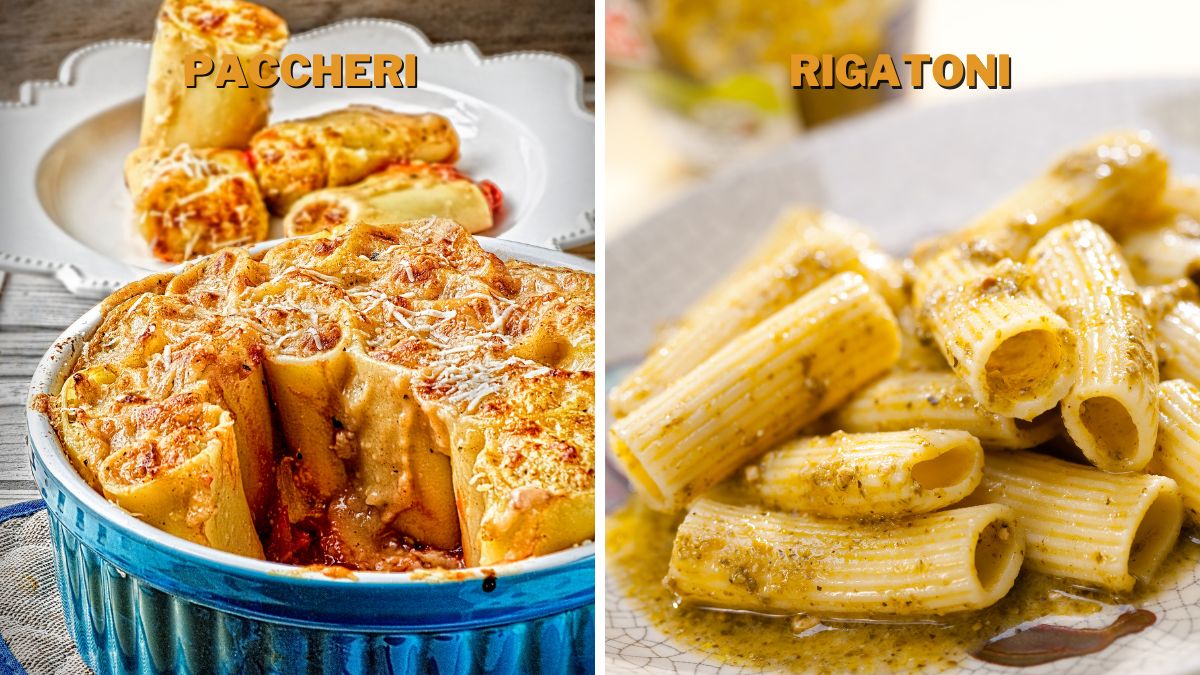Paccheri vs. Rigatoni: Differences & Uses

Have you ever looked at the pasta section in a grocery store only to become overwhelmed and confused by the sheer number of options? Maybe you even saw paccheri and rigatoni and thought, “How are they different?”
Paccheri and rigatoni are two different pasta types that both have unique qualities. Paccheri is tubular and has a large diameter, while rigatoni is grooved and has a smaller diameter. This makes paccheri best for pasta dishes with thick sauces, while rigatoni is a better pick for dishes with light sauces.
Keep reading to learn more about the differences between these two popular kinds of pasta, as well as which dish I recommend for each.
Overview of Paccheri & Rigatoni
When making delicious Italian pasta, two of the most popular shapes are paccheri and rigatoni. These two succulent forms of pasta are often mistaken for one another. Fortunately, there are some easy ways to differentiate between the two and make meals that will please any palate.
Paccheri is a large tube-shaped pasta that has ridges on the inner walls. The outer surface is smooth and can be segmented into large circles or squares, depending on how it’s cut.
Rigatoni, on the other hand, is longer than paccheri but still has ridges along its diameter. It has a more spiral-shaped form than paccheri, with the ridges helping to hold more sauce in each bite.
Differences in Shape and Size
When it comes to pasta shapes, paccheri and rigatoni are two of the most popular. But what is the difference between these two shapes? How can you tell them apart?
The most apparent difference between the two is size. Paccheri is larger than rigatoni, having a larger diameter.
The ridges on paccheri are more shallow than those on rigatoni, some paccheri versions even have no ridges, making them a better choice for pasta dishes focusing on sauces; their tubes provide plenty of space for a sauce to cling. Conversely, rigatoni has deeper ridges that make it a better pick for simpler dishes – like baked or cheese-filled recipes – where you still want some texture but don’t want too much sauce.
Both kinds of pasta work well with both creamy and chunky sauces, as well as for baking pasta dishes – so it ultimately comes down to personal preference when choosing between them.
Textural Differences

When it comes to textural differences, paccheri, and rigatoni are quite different. Paccheri has a ridged surface, which is much more pronounced than the grooves found on rigatoni. The ridges on paccheri are designed to retain sauces better and allow for more flavorful bites. This makes paccheri great for heartier dishes, like casseroles or veggie bakes.
Rigatoni, on the other hand, has fewer ridges than paccheri, but they’re still large enough to provide some texture to sauces. That being said, the shape of rigatoni makes them better suited as a base for chunky and light sauces – think of pesto, arrabbiata, or marinara.
Ideal Uses for Paccheri and Rigatoni
The two are different pasta shapes, each suited for different types of recipes. So how do you decide which one to use? Let’s take a look at their ideal uses.
When deciding which of these kinds of pasta to use in a recipe, remember that paccheri is better suited for thicker sauces, while rigatoni works excellent with lighter sauces like pesto or oil-based sauces. Paccheri is also ideal for oven-baked dishes like lasagna and baked ziti.
Its size and shape make it ideal for hearty sauces, as you can stuff them with meat, vegetables, cheeses, or other fillings. Paccheri also works well in soups and stews, but also with seafood!
Rigatoni has ridges that run along its length, similar to penne pasta. Apart from being perfect for holding onto thick creamy sauces such as Alfredo sauce, it’s excellent for cheese-based sauces like macaroni and cheese and ragus. But note that rigatoni can also be used for baked ziti since both kinds of pasta are tubular-shaped.
However, paccheri is much wider – so wide, in fact, that it almost looks like a wide version of macaroni. So if you’re looking for something to add some heft to your dish without taking up as much space on a plate as spaghetti or lasagna noodles would, paccheri might be your best bet.
